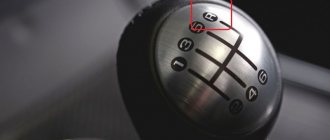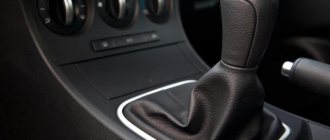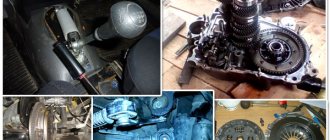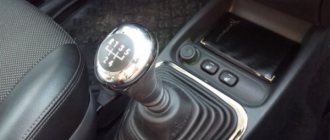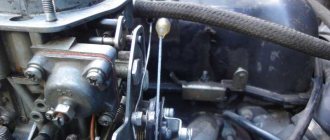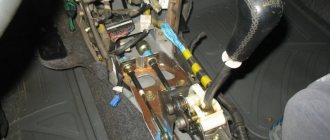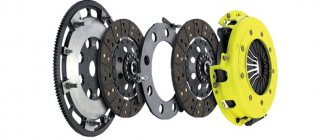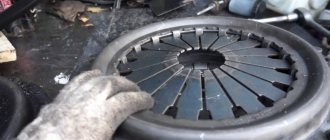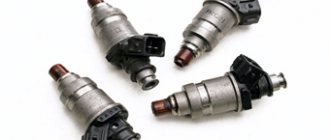Shifting gears in a manual transmission should be easy and quiet, regardless of whether the engine is running. In general, the engine is connected to the gearbox through a single unit - the clutch. It is with this that the difference in ease of switching is associated. There is one exception to this rule, which will be mentioned later.
Mechanism of interaction between the engine and the gearbox
The torque created by the car engine is removed and transmitted further from the flywheel. The flywheel is usually installed at the rear end of the crankshaft and is securely attached to it with several bolts. The bolts are equipped with special fixing belts in the threaded areas or are installed on an anaerobic retainer. Problems with fastening are extremely rare and are associated with gross mistakes by inattentive or unscrupulous servicemen.
The flywheel is a massive steel part with a machined end surface during manufacturing, along which the front friction lining of the clutch driven disc operates. When the clutch is engaged, the driven disk itself is tightly pressed to the flywheel by a powerful diaphragm spring of the drive disk. The spring, working surface and drive plate housing form the clutch basket. The basket is attached to the flywheel with several bolts around the perimeter of the casing.
The driven clutch disc is located between the flywheel and the drive disc, sometimes called the pressure disc. It consists of two friction linings, respectively to the flywheel and to the pressure plate, a damping device and a splined hub that slides freely along the splines of the gearbox input shaft.
When you press the pedal through a mechanical or hydraulic drive, the release bearing moves along the input shaft of the gearbox. The basket spring compresses and ceases to exert pressure on the driven disk. Zero force on the disc linings will result in zero friction between the flywheel and the linings. The primary shaft of the box, connected by splines to the disk hub, will stop its rotation. In such a situation, engaging a gear in the box is no different from the situation when the engine is not running.
The exception mentioned above is another connection between the engine and the gearbox. The front end of the input shaft rests on a bearing pressed into the end of the crankshaft. The friction in a working bearing is insignificant, and it is not able to spin the shaft when the working clutch is depressed. If rotation is difficult due to bearing wear, the shaft may continue to rotate, and the gearbox synchronizer will have to overcome the resulting parasitic torque with its internal friction. Shifting into gear will be difficult.
We recommend: How to choose tires for a car?
Difficulty shifting due to clutch fault
A sign of such a malfunction will be easy engagement of the gear when the engine is off and difficulty when trying to engage first or reverse gear with the car stationary with the engine running. Possible causes may be the following malfunctions.
- Incomplete clutch release due to problems with the drive. It is possible that the hydraulics may become airy, the mechanical drive adjustments may be disrupted, or the shape of parts may be distorted, for example, worn rods or a bent release bearing fork.
- Warping of the surfaces of friction pairs in the clutch. Happens when parts overheat. Both clutch discs and the flywheel can take on a wave-like shape. At the same time, it is not possible to completely retract the pressure plate; the clutch, as they say, “leads.”
- Exfoliated fibrous material from the linings got into the gaps between the driven disk and the driving surfaces.
- It is difficult to move the disk hub along the splines of the input shaft; the disk jams and continues to rub against the flywheel, although the force has already been removed from it.
- The clutch basket spring is deformed and the pressure plate operates skewed.
- The driven disk was stuck to the flywheel after the car had been parked for a long time.
Transmission problems
Ultimately, any malfunctions in the box lead to difficulties when switching. But this manifests itself already while the car is moving. That is, again with the engine running.
Most often the problem is caused by a faulty synchronizer. This simple device is designed, due to internal friction, to equalize the relative speeds of rotation of gears that engage in mesh. At the same time, due to the same friction, it wears out itself. It all ends with the fact that without grinding and great effort, it will not be possible to drive the gears into engagement. Treatment is to replace the synchronizer assembly. Together with the clutch and gear of a specific transmission.
There may also be problems with the switching mechanisms. For example, with forks. They rub along the annular grooves of the couplings and, despite the special very hard coating, also wear out over time. The transmissions first begin to fail, and then a complete failure occurs.
There are other causes of transmission strikes, but their occurrence can be delayed by the simple procedure of regular oil changes. You should not blindly believe the factory claims that oil is poured there for life. It may be so, but everyone will still want to extend this life. The oil ages and becomes dirty. By the end of its life, the cloudy slurry drained from there can hardly be called oil.
We recommend: Is it possible to flush the cooling system with Coca-Cola or citric acid?
Automatic boxes
As strange as it may sound, theoretically there are no fundamental differences between automatic transmission and manual transmission. Everywhere there are friction pairs (clutches or sets of wet discs), gear transmissions and an oil bath. Therefore, the diseases are the same, as are the measures for repair and prevention. There is no need to allow power slipping during sudden starts, skip oil changes and overheat the mechanisms. It’s just that this is even more relevant for automatic transmissions. The mechanisms here are more delicate, the oil requirements are high, and the cost of repairs is many times higher.
The situation is aggravated by the presence of complex hydraulic automation. Gear shifting here is controlled by a set of valves, which are vitally important to work with clean oil. What a manual transmission can tolerate, an automatic transmission will not tolerate. And instead of a clutch, a torque converter works here, which generates a lot of heat. The properties of the oil deteriorate sharply when heated. The presence of oil radiators does not always help. And to reassemble the box you will need a highly paid specialist with the required qualifications.
Problems with switching to automatic transmission
Shifting problems with automatic transmissions are not uncommon. Problems with the automatic machine arise for several reasons.
- backstage malfunction . This mechanism is the most problematic in old-type automatic transmissions. To eliminate the malfunction, the unit will need to be replaced. In most cases, it will be necessary to dismantle the gearbox for these purposes;
- insufficient oil level . The presence of lubricant leaks on the automatic transmission housing may indicate wear of the sealing gaskets, which are not difficult to replace yourself. After this, you need to change the oil in the box. Also, owners of cars with an automatic transmission are recommended to visually inspect the gearbox for oil leaks at least once every 2000 km;
- problems with the transmission control unit can ultimately cause the automatic transmission to completely lock up. To fix the problem, you will need to replace the failed mechanism and thoroughly inspect the electrical part of the gearbox.
Important! To solve problems with automatic transmission, it is recommended to conduct computer diagnostics of transmission faults.
Malfunctions when turning on gears and their elimination
The main components of a modern car are characterized by the same operating principles, despite significant differences in their design. In particular, this also applies to manual transmissions (if we do not consider rear-wheel drive cars, in which the lever is connected directly to the transmission).
Front-wheel drive vehicles can have either a longitudinal or transverse gearbox. In the latter case, a link is used for communication between the motor and the gearbox; on some models (for example, on the Ladovsky Vesta and Kalina) a cable drive is used. It is considered simpler and more reliable, but this design is not without its drawbacks and can fail.
So, let's look at the main reasons why gears do not engage when the engine is running.
Traction, drawstring
Since we have already mentioned domestic cars with a transverse power unit (from the “Nine” to the “Priora”), then when the above-mentioned problem appears, it is first necessary to begin the search for the culprits with these mechanisms.
If you notice that when the car starts moving, the gearbox lever rattles chaotically and unpleasantly, most likely it is the rocker that has flown out of its mounting location. This type of malfunction occurs especially often on cars of the Lada Samara family of the first two generations. The solution is to replace the link or fastener element with new ones. We can say that this is the most obvious and easily fixable malfunction of this kind.
Cable
On cars of later years of production, a cable is used instead of a rocker. If this cable breaks, you will not be able to engage the gear, but not only with the engine running, but also with the engine turned off. This is what will indicate that the drive cable is the likely culprit. Replacing it is not difficult, and it is inexpensive compared to other components and parts.
Insufficient transmission oil level
The box, like the engine, may lose its seal, which will lead to lubricant leakage. If there is a deficiency of it, you will feel that the gears are “stuck” with strain, since the engagement of the gears in the absence of oil occurs with great difficulty. If the problem is not corrected in time, the synchronizers will eventually fail and costly repairs will be required.
Manual transmission: What you need to know when shifting gears
The result is premature wear of the clutch disc. In order to keep the car from rolling on an incline, you need to depress the brake pedal. In order to start, of course, you will have to press the clutch and smoothly press the gas, releasing the clutch. In this case, you will reduce the load time on the clutch basket and release bearing. You can also hold the car by maintaining certain engine speeds, catching a certain moment when you release the clutch and press the gas.
We recommend: How to make a heated steering wheel with your own hands?
Surprised? But in fact, this advice is really very important, because having a habit of leaving your hand on the gear shift knob can lead to premature transmission failure. If you most often leave your hand on the gearbox when stopped in a traffic jam or at a traffic light, then the first gear of the manual transmission suffers the most. Remember that by placing your hand on the gearshift knob, you create extra pressure on it, which is transferred to the gearbox. As a result, excess pressure on the handle can lead to unfree shifting of the desired gear. This can damage the gear shift knob as well as the transmission itself.
Clutch fork
It’s rare, but it happens, for example, I had such a problem once on a VAZ 2105; the fork itself that retracted the clutch disc broke. Apparently it was not of very good quality. Why am I writing this down as a complex problem, because in order to replace it, you often need to remove the entire box, and this is no longer easy! Especially on front wheel drive. ALTHOUGH now people's “masters” in garages change it without removing the manual transmission.
For what reasons do interruptions occur?
There can be many reasons why gears do not shift when the engine is running. However, all of them, in one way or another, are connected with the two most important units of the car - the engine or gearbox. In case of serious damage, you should contact a good car service.
If the problem is in the gearbox, it will need to be removed for further disassembly and troubleshooting. If the problem is with engine components, they may need to be replaced. However, there are cases when, to eliminate a malfunction, it is enough to carry out preventive maintenance: removal, lubrication and careful adjustment of the components.
Principle of operation
The working diagram of the gearbox is as follows. The drive shaft receives rotation from the driven shaft and transmits it to the intermediate shaft. If the gearbox is set to neutral speed, there is no engagement of the intermediate shaft gears with the driven one, the car is immobilized, since rotation is not transmitted.
When a gear is engaged, the driver engages the driven element gear with a specific intermediate gear. And rotation begins to be transmitted from the driven shaft to the wheels. The car starts to move.
The necessary gears are engaged by a control unit consisting of three sliders and forks. Each of the forks is equipped with a special groove of the element. That is, the driver, using the gearshift lever and a special rocker, acts on a certain slider, moving it to one side. In this case, the fork on the slide pushes the gear, and it engages. The change in gear shift speed is influenced by engaging gears of different sizes and numbers of teeth.
To prevent the slider with the fork from returning to its original position, the box control unit is equipped with latches. The latter are spring-loaded balls that fit into grooves on the sliders. That is, the slide has grooves in certain places.
When moved to the desired position, the ball retainer jumps into the groove, eliminating the return of the slider. When changing speed, the driver must apply pressure on the slider that exceeds the force of the detent spring so that the ball pops out.
This is a simplified description of the design and operating principle of a manual transmission.
Typically, the VAZ gearbox of classic models works according to this scheme. On some cars the scheme may be slightly different, but the essence of the work is the same - the slider with the fork acts on the gear.
In some cars, the slider in the gearbox, which is responsible for engaging the first gear, also ensures that the reverse gear is engaged. It happens to them that first and reverse gears are difficult to engage
Of course, this breakdown cannot be ignored
On other gearboxes, first and reverse speeds are separated and different sliders are responsible for turning them on. In such cars, problems with engaging first gear may not be reflected in engaging reverse gear.
There are several options why first gear does not engage well. It also all depends on how the cause manifests itself - it is impossible to turn it on, and everything is accompanied by a metallic grinding sound from the side of the box, or the speed turns on, but immediately turns off on its own.
Why is it difficult for the gear lever to shift on a manual transmission?
- After the desired shift has occurred, you need to release the clutch pedal, there is no need to hold it! Because there is increased wear on the clutch disc
- It is advisable to move in the gear that corresponds to a given speed, this relieves both the engine and the gearbox from unnecessary loads, the best is 4th gear, also called “direct”, in this connection the minimum number of gears and all two shafts are occupied (in bypassing the intermediate). This reduces wear on the manual transmission
- A lower gear should be engaged when the speed decreases, just like an upshift when accelerating.
The main causes of malfunctions Mechanics, like automatic ones, are designed to transmit and change torque from the power unit to the wheels, and this must be done comfortably and dynamically. That is, the car must accelerate as quickly as possible and do this without any “jerks” of prohibitive engine speeds (so that it does not “growl like a victim”) and, if possible, have sufficient traction forces.
Drive and clutch cables
For rear-wheel drive models (VAZ 2101 - 2107), the gears are engaged hydraulically. That is, when you press the clutch, the fluid pushes the piston, which in turn pushes the clutch fork, which retracts the disc. For front-wheel drive models (VAZ 2108 - 2115), there is no hydraulic connection; everything is done here by mechanics, or rather by the clutch cable, which is connected to the pedals. If your slave cylinder leaks on a rear-wheel drive car or the cable breaks on a front-wheel drive car, the car will not engage in gear. The “fork” simply won’t work. We just check and replace damaged parts.
Engine mounts
I personally have never had this happen, but many people write that this is a fairly common problem. Actually, the problem is this: the engine hangs on cushions, the gearbox is connected to it (manual transmissions, by the way, have their own cushions). It happens that the fastening breaks, or it unscrews. The engine or “box” may sag, the scenes may break, or they will hit something.
THEN there is another not very serious problem - these are pillows! If the programs don’t turn on, then we watch them.
These malfunctions, AS I THINK, ARE NOT PROBLEMS AT ALL! Anyone can identify them on pits or lifts, and this is done quite quickly. Personally, I came across rockers and cables, using the example of a VAZ, a clutch cable.
However, if you have checked everything, and the gears do not engage with the engine running. Then it’s worth looking at the box itself and the accompanying attachments. Let's move on to complex faults.
